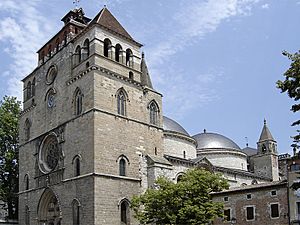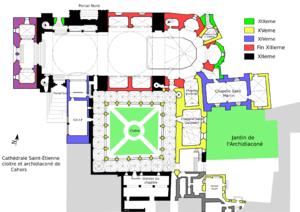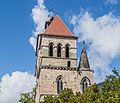Cahors Cathedral facts for kids
Quick facts for kids Cahors CathedralCathédrale Saint-Étienne de Cahors |
|
|---|---|

Cahors Cathedral
|
|
| Religion | |
| Affiliation | Roman Catholic Church |
| Province | Diocese of Cahors |
| Region | Occitanie |
| Rite | Roman |
| Ecclesiastical or organizational status | Cathedral |
| Year consecrated | 1135 |
| Status | Active |
| Location | |
| Location | Cahors, France |
| Architecture | |
| Architectural type | church |
| Architectural style | Gothic, Romanesque |
| Groundbreaking | 1080 |
| Completed | 1135 |
The Cahors Cathedral (in French: Cathédrale Saint-Étienne de Cahors) is a large Roman Catholic church in the town of Cahors, France. It is a very old building, considered a national monument. The cathedral shows a mix of two important building styles: the older Romanesque and the newer Gothic.
Contents
History and Design
Building a Strong Church
This church was built by a bishop named Gerard de Cardaillac. He started building it in the 11th century. It was built on the site of an even older church from the 7th century. That first church was built by St. Didier of Cahors.
The new cathedral was officially opened by Pope Calixtus II on September 10, 1119. It was mostly finished around 1135. The church is right in the middle of Cahors. It looks very strong, almost like a fortress. This is because the local bishops were also powerful leaders in the area.
The Front of the Cathedral
The main front of the church was updated between 1316 and 1324. This work was done by Guillaume de Labroue. He was a cousin of Pope John XXII. The front looks like a heavy castle wall. It has a covered entrance area with a bell tower above it. This tower is placed between two other towers.
The six windows on the front are quite narrow. The only parts that clearly show it's a church are the beautiful main entrance. This entrance has three layers of carvings. Above it is a row of small arches and a large round window called a rose window. On the northern side, there's another entrance. It's in the Romanesque style and also looks very strong.
Inside the Cathedral
The main hall, called the nave, is very bright. It is about 44 meters long and 20 meters wide. It has two huge domes that are 32 meters high. These domes are in a style similar to buildings from the Byzantine Empire. They rest on special curved supports called pendentives. What's unusual is that this cathedral does not have a transept. A transept is a part of a church that crosses the main hall, making the building look like a cross.
One of the domes has paintings from the 14th century. These paintings show the stoning of St. Stephen. They also show eight prophets, each riding an animal. This style is like old Greek or Hindu art. The walls of the nave have many other old paintings from the Middle Ages.
The Altar Area (Apse)
The area around the main altar is called the Apse. It is built in the Gothic style, but it sits on an older Romanesque base. You can see this in the columns with their decorated tops. The apse has three small chapels with sculptures. The white color of the apse looks nice against the colorful stained glass windows and paintings in the choir area.
There are also several tombs here. One is the tomb of Alain de Solminihac. The cathedral also keeps a very special item called the Holy Cap. People believe this cap was worn by Jesus Christ. It was brought to France by Bishop Gerard de Cardillac after he traveled to the Holy Land in 1113.
Other Parts of the Cathedral
The Cloister
If you go through a door on the right side of the choir, you will find the cloister. A cloister is a covered walkway, usually around a courtyard, in a monastery or cathedral. This one was built in 1504 by Bishop Anthony of Luzech. It is in the Flamboyant Gothic style, which means it has very fancy and flame-like decorations. The cloister shows scenes of everyday life and a statue of the Madonna.
On the western side of the cloister is the St. Gaubert Chapel. The ceiling of this chapel has paintings from the Italian Renaissance. On the walls, there are frescoes from the 15th century. These paintings show the Last Judgement. Today, this chapel is a museum of Religious Art.
Gallery
See also
 In Spanish: Catedral de Cahors para niños
In Spanish: Catedral de Cahors para niños
- List of Gothic Cathedrals in Europe
- History of medieval Arabic and Western European domes






